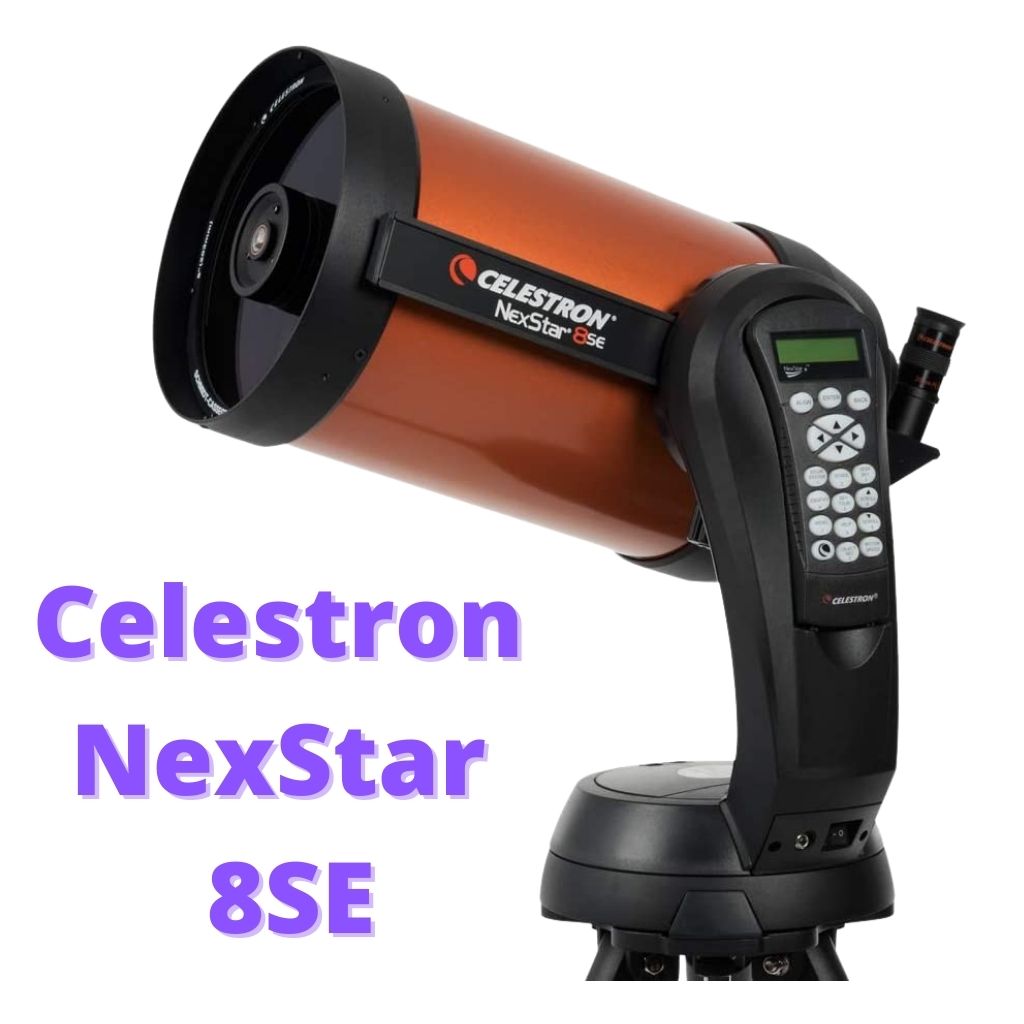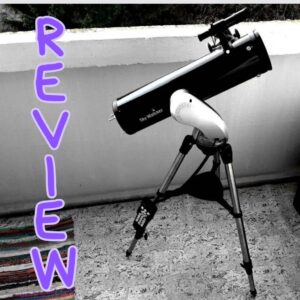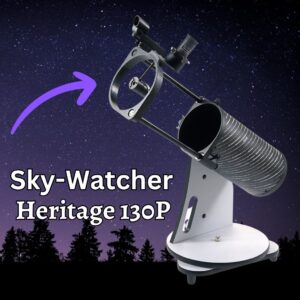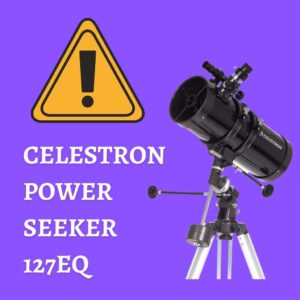This site contains affiliate links to products. I may receive a commission for purchases made through these links.
The Celestron NexStar 8SE SCT is the largest telescope in the Celestron SE series, and as with telescopes, bigger is generally better. This Schmidt-Cassegrain telescope is mounted on a computerized alt-azimuth mount and boasts high-quality optics, including a large 8-inch primary mirror and a focal length of 2032mm (80 inches). Despite the long focal length, the telescope is relatively compact, measuring only 432mm long thanks to its SCT optical design.
In this Celestron Nexstar 8SE review, we’ll look at the telescope specifications, accessories, advantages, disadvantages, and overall performance to help you decide before purchasing it.
Whether you’re new to stargazing or a seasoned veteran, read this first to learn more about Celestron NexStar 8SE SCT, an excellent choice for astronomy enthusiasts and astrophotographers.
Specifications of the Celestron NexStar 8SE SCT
The Celestron NexStar 8SE is a Schmidt-Cassegrain telescope with the following specifications
| Optical design | Schmidt-Cassegrain |
| Aperture | 203.2 mm (8 in) |
| Focal length | 2032 mm (80 in) |
| Focal ratio | F10 |
| Mount | Motorized Single Fork Arm alt-azimuth |
| Power supply | 8-AA batteries (not included) |
| Highest useful magnification | 480 x |
| Optical tube length | 17 in (431.8 mm) |
| Tube Diameter | 226mm |
| Ota weight | 24 lb (10.89 kg) |
| Tripod and mount weight | 9 lb (4.08 kg) |
| Drive Type | DC Servo motors |
| Camera/Eyepiece Connection | 1.25″ Nosepiece |
Celestron NexStar 8SE SCT telescope’s optical performance
(Schmidt-Cassegrain Optical Design)
The main feature of the Celestron NexStar 8SE is the Schmidt-Cassegrain optical design. This design allows for a long focal-length telescope to be packed into a small package.
The telescope uses two mirrors, like a Newtonian reflector, to produce an image in the eyepiece, with the position of the eyepiece holder and the tilt of the small secondary mirror being the main difference.
In this design, the secondary mirror is parallel to the primary mirror. The eyepiece holder is positioned behind the opening in the center of the primary mirror where the light enters.
The light bounces from the primary to the secondary mirror, which then focuses the light back to the primary mirror’s center and into the opening for the eyepiece.
This design may seem complicated, but it allows long focal lengths to be squeezed into a small optical tube. The Celestron NexStar 8SE has a final focal length of 2032mm, which would be challenging to operate if it were in a 2m-long telescope.
The longer optical tube of the Celestron NexStar 8SE gathers up to 77% more light than other NexStar models, resulting in exceptional viewing and impressive magnifications.
To calculate the magnification, divide the telescope’s focal length by the eyepiece’s focal length. If the telescope has a short focal length, you have to use very small eyepieces with small exit pupils to achieve a high magnification. However, It is not an ideal solution.
But with a long focal length telescope, larger eyepieces can be used that are more comfortable to look through while still achieving the same high magnification.
To learn more about the Schmidt-Cassegrain optical design, read this article Schmidt-Cassegrain vs. Maksutov-Cassegrain.
Collimating the Celestron NexStar 8SE SCT
Collimation means proper alignment of telescope mirrors. If your telescope is out of collimation, you will get a blurry image and won’t be able to focus the object in the eyepiece.
Collimation is required only for Newtonian reflectors using mirrors as the optics. It is not needed for the refractors using lenses.
But what about the Schmidt-Cassegrain telescope (SCT)?
Schmidt-Cassegrain telescope is a Newtonian reflector because it uses mirrors and not lenses. However, it is a closed system where you can’t really adjust the primary mirror.
The only adjustment you can make is to the secondary mirror, and you don’t even need collimation tools like a Cheshire eyepiece or a laser collimator.
It is an easy process, but it is hard to explain. You will understand it much better from the video below made by Astronomy and Nature TV:
Motorized Alt-Azimuth Mount
The Celestron Nexstar 8SE is designed with a computerized goto mount that incorporates NexStar computer technology, providing an advanced upgrade from the manual mount.
Unlike the manual mount, which requires manual navigation across the sky and self-finding of objects, its computerized mount makes the process much easier.
The computerized mount automatically locates and points the telescope to the desired object using a hand controller with a database of over 40,000 objects that can be searched by name or catalog number.
Before starting your stargazing session, you must do a star alignment to allow the mount’s computer to locate objects accurately.
To align the mount, you can point the telescope to a bright star and choose a second star from the menu. The telescope mount will then automatically move to that star, and once you recenter it in the eyepiece, the alignment is complete.
The mount’s computerized tracking system allows the desired object to always remain in the field of view in the eyepiece. This feature is an excellent advantage over the manual mount, where you must make minor adjustments to keep the object in view.
You may also like: Are GoTo Telescopes Worth It? (My Real Experience)
Powering Your Celestron NexStar 8SE SCT
Computerized mounts need power, and they usually have a battery compartment somewhere to put the AA batteries in. These batteries will power your telescope, so you don’t have to run any external cables.
However, the only limitation is that they last only a short time. Hence, consider an external power supply source if you plan to have a stargazing session under the stars.
If you stargaze in your backyard, you can buy a power adapter and run your telescope from the outlet nearby. However, if you’re venturing into the wilderness, bringing an external battery is a smart idea.
There are many options available, but I recommend the Celestron PowerTank.
The Celestron PowerTank is a rechargeable power source into which you can plug your telescope or other devices, much like a car battery. The PowerTank can last an entire night and is reasonably priced.
Additionally, it has a variety of other uses beyond powering your telescope, making it a versatile investment.
How to set up and use the Celestron NexStar 8SE SCT?
The Celestron NexStar 8SE may look cumbersome to set up and move around, but that couldn’t be farther from the truth.
Thanks to the reasonably straightforward instruction manual, users can set it up in as little as 15 minutes once they get used to it.
Connecting the telescope to the mount is the most challenging part of the setup process, but it’s easily manageable by following the steps below.
- First, attach the scope to the single-armed fork mount on a soft surface.
- Second, ensure it’s firmly locked in place before attaching the fork to the stand.
That said, the build quality of the NexStar 8SE is robust, but that does not imply that it’s indestructible, so handle it with care. In addition, a telescope that uses mirrors will require collimation.
The collimation process involves adjusting the three screws at the telescope’s rear that hold the mirror in place.
To make collimation easier and less risky, it’s best to replace the screws with a set of ‘Bob’s Knobs.’
Lastly, when setting up your 8SE, consider temperature.
Being a catadioptric scope, your 8SE optical tube is a sealed unit; hence it takes a while for the air trapped inside to equalize its temperature with the outside.
You won’t get excellent performance when there’s a temperature difference between the scope and the air outside.
For optimal viewing, set up the scope outside 2-3 hours before use. If it’s a cold night, use a dew shield to prevent the scope from misting up with condensation.
Once you are done observing and ready to pack up, taking down the telescope is just as quick, as the scope easily fits into small dimensions, making it easy to transport.
Advantages of the Celestron NexStar 8SE SCT telescope
- Large aperture
- Fantastic optics
- Extremely bright, sharp views
- Low maintenance
- High-quality materials
- Easy to set up
- Simple to use
- GoTo features to find objects easily
- Good value for the money
- Compact and portable for traveling
Disadvantages of the Celestron NexStar 8SE SCT telescope
- Beginners may need help at first
- Expensive, hence not a budget telescope
- Battery life is not great
- Mount is not the steadiest
- Finder scope can be challenging to align
- Only comes with one eyepiece
What can you see with a Celestron Nexstar 8se?
Once you have successfully set up and aligned your Celestron NexStar 8SE, the possibilities of what you can see are endless.
With this telescope, you can observe many fascinating celestial objects in our solar system, including:
- The phases of Mercury and Venus
- The Moon’s ridges, faults, valleys, mountains, flatlands, craters, and more – are all visible as long as the atmospheric conditions and collimation are good.
- The bands of Jupiter, along with its cloud belts, Moons, and disks.
- Mars’ albedo shading, ice caps, and dust storms
- Saturn’s rings and the division in them, its cloud belts, and a half dozen Moons
- Uranus as a small turquoise disk, and perhaps a Moon or two
- Neptune and its Moon, Triton
You can also see celestial objects beyond our solar system. With half-decent skies, you can complete the entire Messier catalog and even the Herschel 400 catalog with some effort.
Along with hundreds of nebulae, you can also have easy access to thousands of galaxies and star clusters, thanks to the 8SE’s GoTo system.
Is Celestron Nexstar 8SE good for Astrophotography?
When it comes to planetary and Moon astrophotography, the Celestron NexStar 8SE is more than capable. Celestron Nexstar 8SE’s focal length is long, which makes it a perfect fit for high magnification, which is essential for planetary observation and astrophotography.
But if you are thinking about buying another scope for your astrophotography, let me stop you there. You don’t have to sell this telescope and buy a new one with an EQ mount for astrophotography.
You can upgrade it with an equatorial wedge for Celestron Nexstar 8SE, known as the Celestron EQ Wedge for NexStar Evolution/SE.
This accessory can quickly turn your AZ mount into an equatorial mount, making deep-sky astrophotography possible without having to buy a new telescope.
You may hear that you need a German equatorial mount for astrophotography. Well, that’s true, but I have done astrophotography and DSLR on the AZ mount, and I was happy with the outcome.
While it may not be the easiest option, it is still feasible.
Read more: Celestron 8SE: Your Complete Guide to Astrophotography Success
Celestron EQ Wedge For Astrophotography
The Celestron EQ Wedge will transform your AZ mount into an EQ mount. Now you can use your Celestron NexStar 8SE or another telescope from SE or Evolution series for astrophotography.
However, it is not an ideal solution and replacement for an actual EQ mount because it has no polar scope to accurately polar align the mount. But it is good enough to take longer exposures without the field rotation that is present on an AZ mount.
The telescope also has an auto guider port, so you can use a guiding scope to improve the mount’s tracking. If you saw my pictures taken with an AZ mount, this setup with the EQ Wedge and guiding scope will get you much better results.
Celestron Nexstar 8SE telescope ultimate package
The Celestron NexStar 8SE telescope bundle is an all-inclusive package that comes with an Apertura Plossl Eyepiece and Filter Kit. The kit comprises five eyepieces, a 2x Barlow Lens, six color filters, and an aluminum carry case.
In addition, the bundle includes a Portable Power supply, which is convenient for powering your telescope when you’re out in the field and don’t want to rely on AA batteries. This DC Battery is also handy when the lights go out.
Moreover, the NexStar 8SE telescope bundle also features an AC Adapter, enabling you to power your telescope from a regular AC outlet.
Accessories to upgrade the Celestron NexStar 8SE
As you can see from the previous section, this telescope does come with some impressive accessories; hence you don’t need to upgrade the telescope immediately. However, you will definitely need to do it later, like with every telescope, so here are my recommendations.
Finder scope or telrad
The first recommendation is to upgrade the red dot finder that comes with the telescope. It is complete garbage, and for a bit of money, you can have a massive upgrade.
An excellent upgrade I recommend is the Astromania 6×30 Finder Scope, Black.
Another fantastic upgrade you can go for is the Telrad finderscope. It is up to you.
2″ Diagonal kit
Another fantastic accessory you might need to enhance your stargazing experience with this telescope is a 2-inch eyepiece upgrade.
The telescope is equipped with a 1.25-inch diagonal, and going for a 2-inch diagonal and eyepieces will vastly increase the stargazing experience with this scope. One option to consider is the Astronomia 2-inch eyepiece, diagonal, and filter kit.
Focal reducer
A focal reducer accessory is helpful for those who want to enhance their astrophotography experience with this telescope. By design, the field of view of this telescope is small because of its long focal length.
To widen the field of view, you need to shorten the focal length using a focal reducer.
This is especially useful for observing large deep-sky objects and astrophotography. With a focal reducer, you can have better Celestron Nexstar 8SE images.
An excellent focal reducer I recommend is the Celestron f/6.3 Reducer Corrector for C Series Telescopes.
Celestron SkyPortal WIFI Module
This one is more of a luxury upgrade. The Celestron SkyPortal WIFI module will allow you to control your telescope remotely via a smartphone app or computer.
I have written more about this WiFi module in this article: Skyportal WiFi Module Review (Read This First!)
Solar filter for Celestron Nexstar 8SE
If you plan to observe the sun with the Celestron Nexstar 8SE, you will need a solar filter optical device to observe it safely.
A solar filter helps to block harmful ultraviolet and infrared radiation while allowing visible light to pass through. Without a solar filter, an observer will surely damage their eyes.
A fantastic Solar filter is the EclipSmart Eclipse Solar Filter. This nifty accessory is ideal for viewing the Sun and eclipses, including the upcoming 2023 Annular Solar Eclipse and 2024 Total Solar Eclipse.
With the EclipSmart Eclipse Solar Filter, you can easily transform Celestron Nexstar 8SE into a solar scope.
Is the Celestron NexStar 8SE SCT a good telescope for beginners?
The Celestron NexStar 8SE is a fantastic scope and one that is suitable to all, whether you’re a beginner, intermediate, or advanced skywatcher.
Finding a scope that is both easy for beginners to use and also pleases sophisticated Sky-Watchers is pretty hard to come by, but the Celestron NexStar 8SE is one such instrument that manages to do so.
In addition, the Celestron NexStar 8SE is a fantastic option for astrophotographers, thanks to its smooth and precise tracking.
Although it does carry a fair amount of weight, the telescope can be packed away and set up in no time, so there’s no need to leave it out and occupy valuable space in your home.
FAQs about Celestron NexStar 8SE
Let’s delve into some additional frequently asked questions about NexStar 8SE.
Is the Celestron NexStar 8SE SCT a good investment?
The Celestron NexStar 8SE is a perfect investment because of its excellent optics, ease of use, and a motorized mount. Plus, it’s a versatile option that can be upgraded with an EQ Wedge for astrophotography. It is a great all-rounder to start in astronomy.
How old is the NexStar 8SE?
The Celestron NexStar 8SE is 53 years old. It was first introduced in 1970 and has undergone several model updates since then. Despite its age, it remains a fantastic instrument for astronomy beginners and is still popular today. Its continued popularity is a testament to its reliability, ease of use, and impressive capabilities.
What is the difference between Celestron 6SE and 8SE?
The only difference between Celestron 6SE and 8SE is the size of the scope on the mount and weight. The 6SE and 8SE telescopes both use the same mount, but the 6SE weighs 30lb, while the 8SE weighs 33lb when fully assembled.
Read the full review here: Nexstar 6SE Telescope Review
Can you see galaxies with Celestron NexStar 8SE?
The Celestron Nexstar 8SE aperture size enables you to see galaxies. The big aperture of the telescope provides enough light-gathering ability to reveal dimmer objects like galaxies in detail.
With the telescope’s GoTo system and the ability to track deep-space objects, it is possible to find and observe many galaxies, like the Andromeda Galaxy.
Takeaway: The Celestron Nexstar 8SE telescope is a good investment
The Celestron NexStar 8SE is an excellent choice for beginner and intermediate astronomers looking to upgrade their gear.
Setting up and using this telescope is a breeze, and the images it produces through the eyepiece are truly stunning – even seasoned astronomers will be blown away by the 77% increase in light-gathering power compared to a 6-inch refractor.
That said, it’s worth noting that you’ll need to invest in a separate power source and vibration dampeners for the mount to get the most out of your observing sessions.
But other than that, the Celestron NexStar 8SE telescope is perfect for anyone who loves exploring the night sky. With its easy-to-use focusing system and precision optics, this telescope is an excellent investment that will undoubtedly provide a breathtaking experience every time.
Don’t forget to subscribe to our newsletter where you’ll find the latest cosmic discoveries, expert stargazing tips, and exclusive subscriber deals. Embark on your cosmic journey if you haven’t already!
You may also like:














